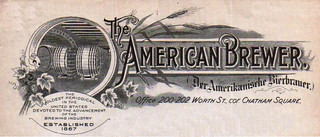In the past year, we released two beers inspired by historical pilsners: Dreher’s Original Bohemian Lager, which was inspired by the original lager from Anton Dreher’s Michelob brewery, and Beer for Connoisseurs, which was inspired by the American version of Michelob. These historical recreations are easily my favorite beers to brew since they help me learn more about the history of beer production and connect the dots from old school brewing to where we are today with modern equipment, techniques, and recipes. In addition to those two lagers, we’ve released a variety of Classic American Pilsners that have used blends of old school hops and newer varieties. However, we haven’t released a Classic American Pils that was brewed in a manner most similar to the CAP’s of the late 1800’s or early 1900’s and I thought it was time that we brewed a beer to honor the work of one of the most influential (and perhaps controversial) brewing chemists in brewing history: Anton Schwarz.
Anton Schwarz is widely recognized for being the brewer that popularized adjunct brewing in the United States. Contrary to popular belief, brewing with rice or corn was not intended to be a method of brewing beer cheaply. Schwarz moved to the United States in 1868 after studying chemistry in Prague and working for several breweries in Budapest. When Schwarz arrived in the United States, the country was riddled with inconsistent beer, poor brewing practices, and brewing technology lagged far behind that of European and English breweries. Shortly after arriving in the USA, Schwarz found a job working as a contributor for a brewing publication, “Der Amerikanische Bierbrauer (The American Brewer)” in New York. It didn’t take long to realize that Schwarz had far more experience and knowledge of brewing than the other writers and within a year he was made the editor of the publication and he eventually bought it himself.
Over the course of Schwarz’s 27 years writing, his articles helped educate brewers and his contributions to American brewing can’t be overlooked. Today, his most well known contribution comes from his 1869 article “Brewing with Raw Cereals, Especially Rice” in which he detailed the advantages of brewing with adjuncts. At the time, American barley was poorly suited for brewing and many of the beers of the time were deemed to be inappropriately hazy (imagine what 1860’s consumers would say today with the introduction of beers that are brewed with a goal of permanent haze in mind!) due to the high protein content of the barley varieties that were grown. What Schwarz advocated for was removing a portion of the barley in favor of rice to lower the overall protein content and thus eliminate the source of excessive haze. By using rice, there would be very little protein and less oils than are common with other adjuncts such as corn and the beers could be produced to be as pale as their European counterparts.
With that in mind, the goal was never to just produce the cheapest beer possible. The goal was to use adjuncts to produce a higher quality product. The beers brewed with that method still typically used the same hopping rates as German or Czech pilsners and with the introduction of adjuncts, they also had the same exceptionally pale color, tremendous clarity, and a high degree of fermentability that resulted in a particularly crisp, dry, refreshing beer. Less than 20 years after the publication of Schwarz’s article, another great American brewing chemist (Dr. Siebel who founded what is now America’s oldest brewing school) had the following to say about adjunct beers: “The well-to-do classes demand a new, light, bright, brisk, bitter beer, which, if brewed from malt alone, would not meet the requirements of the majority of that class. It is well known that those brewers whose light beers are renowned use a percentage of rice or corn in their manufacture.”
It wasn’t until the introduction of the American Light Lager that the use of adjuncts really was pushed to the limits and the goal was no longer to produce full flavored beers with those bright, brisk attributes, but rather to produce beer with less flavor and more drinkability and consumers started to view adjuncts as being a way of brewing cheap beer of low quality to sell to the masses. Unfortunately, that mindset has persisted far too long. In recent years, many craft brewers have attempted to distance themselves from mass produced beer by making sure to emphasize that they don’t use adjuncts. What those brewers fail to realize is that it’s entirely possible to make a full flavored lager with far greater drinkability with the use of a small amount of adjuncts.
With that in mind, we decided we wanted to bring back the style as Anton Schwarz imagined it and honor him. Our upcoming lager is named “Der Amerikanische Bierbrauer” in honor of Schwarz. In this instance, we are not trying to recreate one particular beer as we did with other historical lagers, but rather to brew a beer in the same style as Schwarz with the highest of quality standards of modern beers. Our example uses the highest quality Czech Saaz to provide a medium-high level of bitterness as well as the signature Saaz floral, spicy aroma that has been coveted for hundreds of years by brewers. The use of a small amount of flaked rice helps us to create a beautifully pale beer and the rest of the grain bill is an extra flavorful Pilsner malt to make sure that the beer is packed with flavor while also being dry, crisp, and drinkable. The bright nature of the flavor is further enhanced by our use of low oxygen brewing and sour wort in the mash and kettle for pH adjustments as well as the very cold fermentation temperature to reduce esters that allows us to naturally carbonate the beer.
This is a beer I’ve been looking forward to for months and now that it is brewed into the tanks, I’m counting down the days until we have it ready to serve.


Leave A Comment